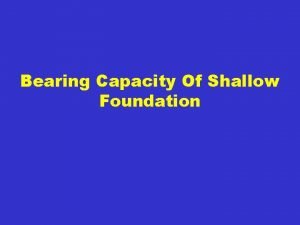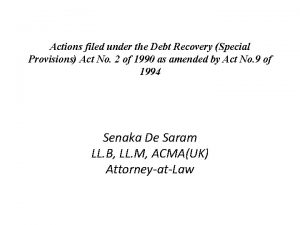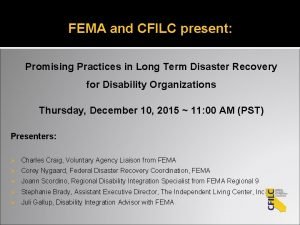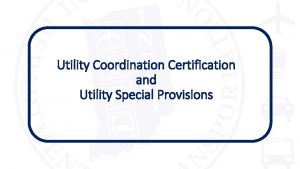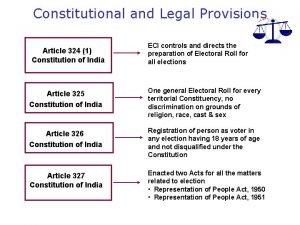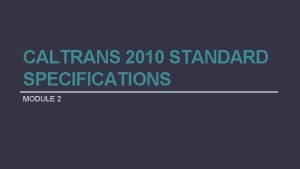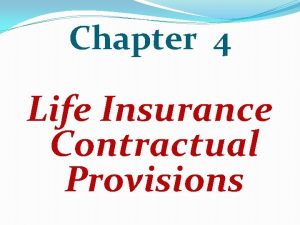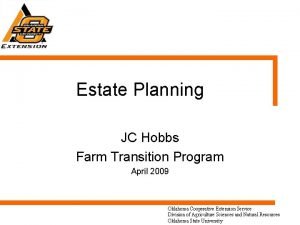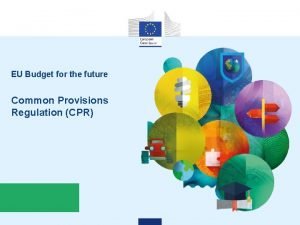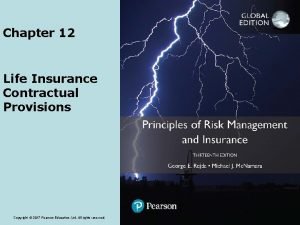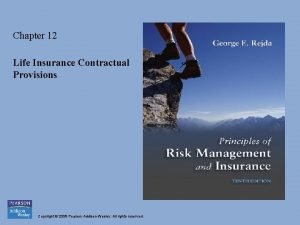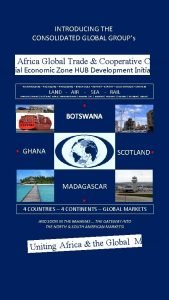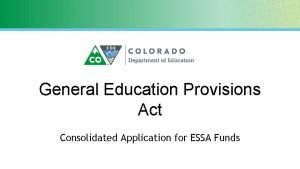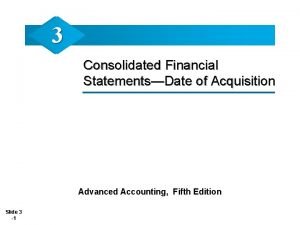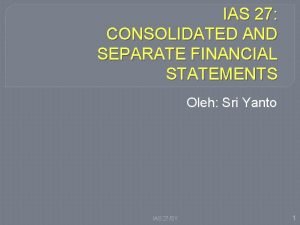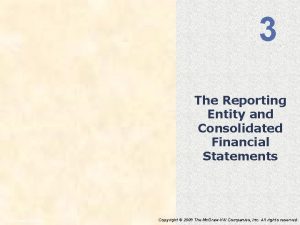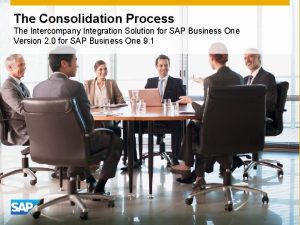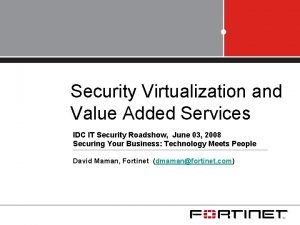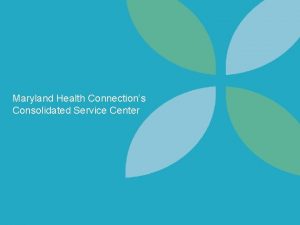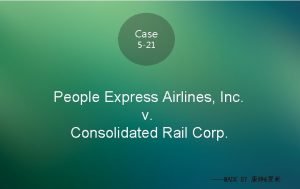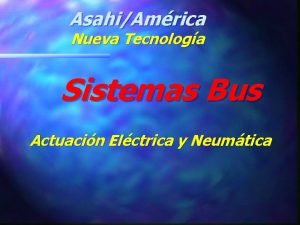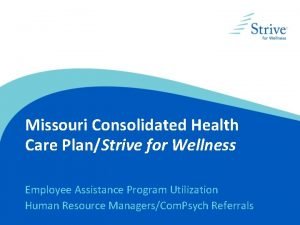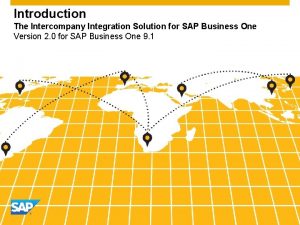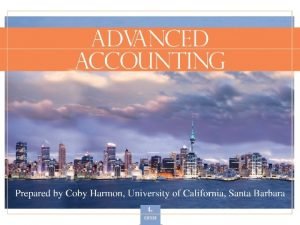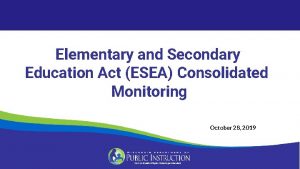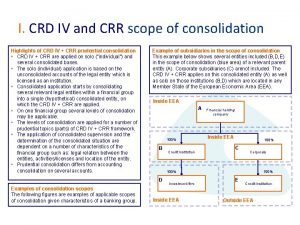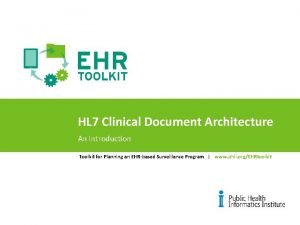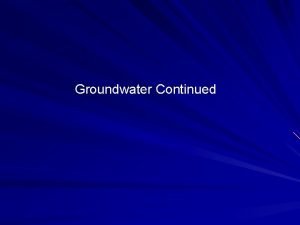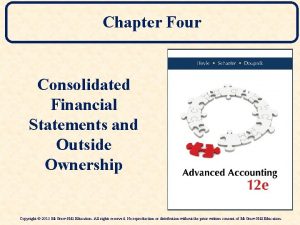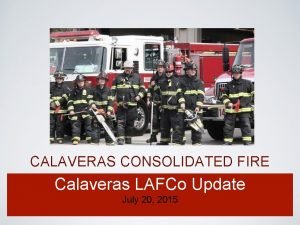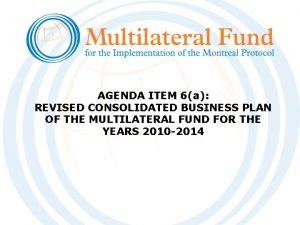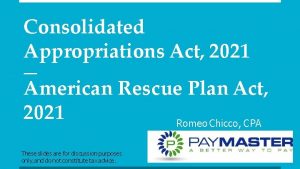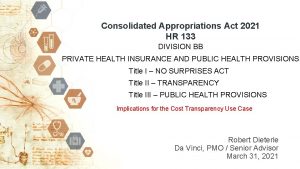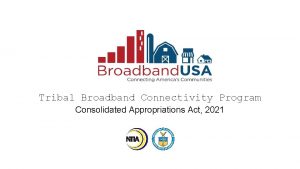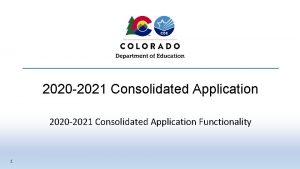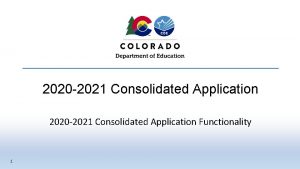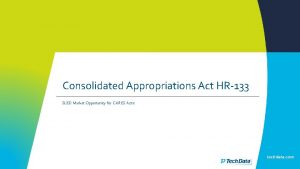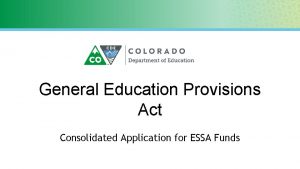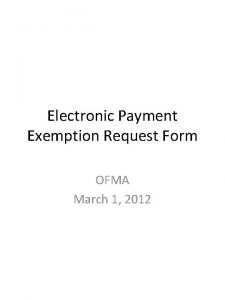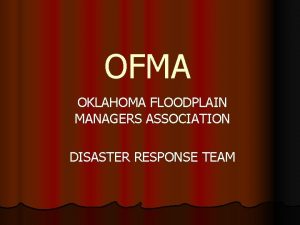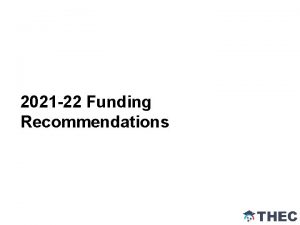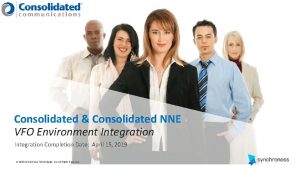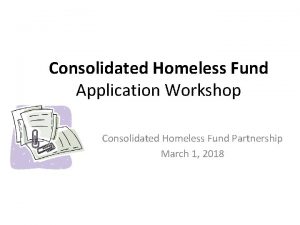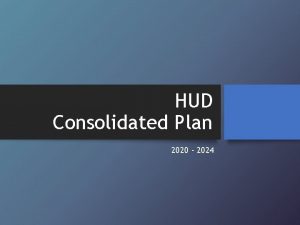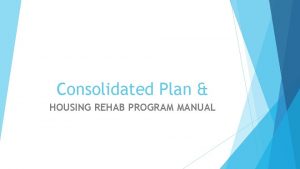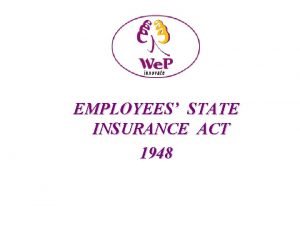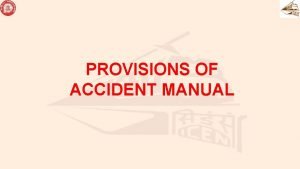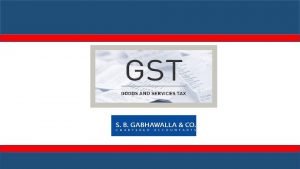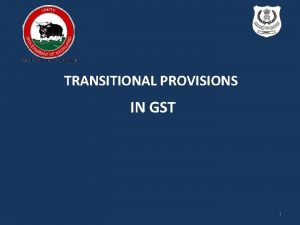Provisions of the Consolidated Appropriations Act 2021 OFMA














































- Slides: 46

Provisions of the Consolidated Appropriations Act, 2021 OFMA Convention January 19, 2021

What We Will Cover � Changes to Paycheck Protection Program � Grants for Shuttered Venue Operations � Benefit plan provisions � Other tax provisions and extenders

Paycheck Protection Program

PPP Expenses are Deductible � CARES Act provided that forgiveness of PPP loans is non-taxable to borrowers � IRS responded: ◦ Expenses paid with nontaxable PPP funds are nondeductible � CAA clarified – expenses now deductible ◦ Applies to both first and second PPP loans � Basis issues?

PPP Reopening – First draw � First time (draw) borrowers: ◦ Generally same provisions as original PPP �<500 employees, 2. 5 x average monthly payroll ◦ Adds 501(c)(6) & destination marketing organizations �<300 employees �Lobbying efforts are <15% receipts, <15% activities, <$1 m expenses ◦ Adds housing cooperatives ◦ Includes those who took employee retention credit � Previous borrowers: ◦ May reapply if borrower returned part or all of the funds ◦ May increase loan as a result of subsequent rule changes

PPP – Ineligible Entities � Entities ineligible for first & second draw loans: ◦ Excluded on first draw ◦ Primarily engaged in political or lobbying activities ◦ Organized in, or has significance to, China or Hong Kong ◦ Received a Shuttered Venue Grant ◦ The President, VP, head of Executive dept. or member of Congress, or spouse of such person own 20% or more ◦ Publicly traded company ◦ Previously received a second draw ◦ Has permanently closed

PPP Second Draw - Summary � Eligibility: ◦ <300 employees (per location) ◦ 25% reduction in gross receipts in any calendar quarter of 2020 quarter vs. 2019 ◦ Has used or will use first draw funds � Loan amount: ◦ 2. 5 x average monthly payroll �Exception: Accommodation & Food Industry (NAISC code 72) � 3. 5 x average monthly payroll ◦ Maximum loan $2, 000

PPP Second Draw – Gross Receipts � Gross receipts includes: ◦ All revenue in whatever form received or accrued from whatever source including: �Sales of products or services �Interest �Dividends �Rents �Royalties �Fees �Commissions �Reduced by returns and allowances � Excludes ◦ First draw PPP loan forgiveness and EIDL advances

PPP Second Draw – Gross Receipts � 25% Reduction ◦ Entity in business all four quarters of 2019 �Compare any calendar quarter 2020 to 2019 or �Compare annual 2020 to 2019 ◦ Entity NOT in business during Q 1 or Q 2 of 2019 �Compare any 2020 quarter to Q 3 or Q 4 of 2019 ◦ Entity NOT in business during Q 1, Q 2, or Q 3 of 2019 �Compare any 2020 quarter to Q 4 of 2019 ◦ Entity NOT in business in 2019, but operational on Feb. 15, 2020 �Compare Q 2, Q 3, or Q 4 of 2020 to Q 1 of 2020

PPP Second Draw – Gross Receipts � Documentation ◦ Relevant tax forms, including annual tax forms, quarterly financial statements or bank statements ◦ Loans over $150, 000 �Documentation submitted with loan application ◦ Loans $150, 000 or less �No documentation required with loan application �Must be submitted on or before loan forgiveness application

PPP Second Draw – Payroll � Payroll calculation options: ◦ 2019 calendar year or ◦ 2020 calendar year or ◦ Precise 1 year period before the date the loan is made � Self-employed/partners ◦ Use 2019 or 2020 � Documentation: ◦ Similar to the first draw ◦ No additional documentation required if: �Used calendar 2019 figures on both first and second draw and �Lender is the same

PPP – Timing � First draw opened 1/11/21 ◦ Targeted to community financial institutions � Second draw opened 1/13/21 ◦ Targeted to community financial institutions � Expected to be fully open week of Jan. 18 th

PPP Forgiveness - Changes � Covered period: ◦ Between 8 & 24 weeks of loan origination date ◦ Alternative covered period eliminated ◦ Allows options which may impact: �Wage reduction’s �FTE’s

PPP Forgiveness - Changes � Payroll costs – include group life, disability, vision, or dental insurance � Eligible expenses expanded to include: ◦ Operations expenses �Software & cloud computing expenses to facilitate business operations and recordkeeping ◦ Property damage �Related to looting and vandalism due to public disturbances in 2020 that was not covered by insurance ◦ Supplier costs �Expenses paid to supplier that are essential to operations ◦ Worker protection expenditures �Operating or capital expenses to adapt to comply with health and safety requirements with COVID-19

PPP Forgiveness - Changes � Maintains � EIDL 60% payroll/40% non-payroll split advance grants ◦ Non-taxable ◦ Expenses paid with grant are deductible ◦ No longer reduce PPP forgiveness

PPP Forgiveness - Changes � Simplified forgiveness for loans under $150, 000 ◦ One page application ◦ Borrowers required to provide: �# of employees �Estimated amount of loan spent on payroll costs �Total value of loan ◦ Borrower also must: �Attest to complying with PPP requirements �Borrower must maintain records � 4 years for employment � 3 years for other ◦ For 2 nd draw loans, borrower is required to provide documentation on loss of revenue

“Gross Receipts” for Not-For-Profits � CAA references Code Section 6033 for not-forprofits to use when determining gross receipts and 25% reduction � Regs. under Sec. 6033 define gross receipts to include proceeds from sale of investments/other property, not the gain � Example: $1 M of proceeds, $800 K of basis, gain of $200 K - $1 M is gross receipts component � Troublesome if client has frequent portfolio trades � Nothing to do with operations

New NFP Borrowers under PPP � Sec. 501(c)(6) trade associations/business leagues and Destination Marketing Organizations (“DMO”) now eligible for PPP loan � Requirements for Sec. 501(c)(6) orgs. : o 300 or fewer employees o Does not receive more than 15% of receipts from lobbying o Lobbying activities are not more than 15% of activities o Lobbying expenditures < $1 M during most recent tax year ended prior to 2/15/2020

New NFP Borrowers under PPP (cont’d) � DMO’s have same requirements as Sec. 501(c)(6) orgs. except for $1 M limit on lobbying � DMO’s can be 501(c) organizations, a quasigovernment entity, or a political subdivision of a state or local government � Sec. 501(c)(6)/DMO uses Second Draw application? o No mention of needing 25% reduction in CAA � Other eligible orgs. : housing cooperatives under Sec. 216(b), veterans orgs. , news orgs. (FP and NFP)

Grants for Shuttered Venue Operations

What is it? �A $15 billion grant program for eligible venue operations who demonstrated a 25% or more reduction in revenues in one 2020 quarter over the same 2019 quarter.

Who are potentially eligible? � Live venue operators and promoters, theatrical producers, or live performing arts organization operators � Museum � Motion � Talent operators picture theater operators representative

Criteria: � Have been fully operational on or before February 29, 2020; � A reduction in gross earned revenue of 25% of more from one 2020 quarter compared to the same quarter in 2019; � Be in operation or intend to resume operations; and � Meet venue requirements � NOTE: An applicant’s revenue does not include amounts received under the CARES Act and the SBA is to use the accrual method of accounting for determining revenue

Grants for Shuttered Venue Operations Cont…. � What entities are not eligible? o Majority owned or controlled by a publicly-traded entity; o Receives more than 10% of gross revenue from Federal Funding in 2019; o Foreign operations; o Operations in more than 10 states; o Gross revenue derived in the adult entertainment industry; o Employ more than 500 FTE’s as of 2/29/20; or o Receiving a PPP loan after December 27, 2020

Size of Grants: � Grants are capped at $10 million. When applying the affiliation rules, the grant is capped at $60 million (entity plus 5 affiliates). � Initial Grant: � Supplemental Grant: o If in operation on January 1, 2019 – 45% of gross earned revenue during 2019 o If began operations after January 1, 2019 – 6 x the average monthly gross earned revenue for each full month in operation in 2019 o Q 1 2021 revenue is not more than 30% of Q 1 2019; grant will equal 50% of initial grant o Supplemental grants cannot be administered until all initial grants submitted within the programs first 60 days have been processed

Disbursement Priority of Grants: � � First Priority – During the first 14 days of the program, grants will be awarded to entities who have had a 90% reduction in revenue from 4/1/20 – 12/31/20 compared to the same period in 2019; Second Priority – During the next 14 days of the program, grants will be awarded to entities who have had a 70% reduction in revenue from 4/1/20 – 12/31/20 compared to the same period in 2019; Thereafter, all eligible entities: Special priority provision - $2 billion of the $15 billion appropriated funds are reserved for the first 60 days of the program for eligible persons or entities with 50 or fewer FTE’s.

What Can the Funds be Used For? � � � For initial grants – costs incurred between March 1, 2020 and December 31, 2021 For supplemental grants – costs incurred through June 30, 2022 Eligible Costs Include: o o o o Payroll Costs – follow PPP guidelines Covered Rent – follow PPP guidelines Covered Utilities – follow PPP guidelines PPE Interest payments on pre 2/15/20 mortgages Payments to Independent Contractors (capped at $100, 000) and Other ordinary and necessary business expenses

Consolidated Appropriations Act, 2021 Benefit Plan Provisions

Families First Coronavirus Response Act � Originally passed into law March 18, 2020 � Implemented new requirements for 1. Sick leave 2. Family and medical leave � Required for employers with less than 500 employees � Tax credits supplemented the cost for employers � Under the FFCRA these benefits were only temporary and ended on December 31, 2020

Families First Coronavirus Response Act and the CAA, 2021 � Paid sick and family leave mandate was NOT extended � But under CAA an employer may VOLUNTARILY elect to extend these benefits through March 31, 2021 � Tax credits remain available ◦ Sick Leave – credit is up to $511/day, maximum $5, 110 per employee ◦ Family and Medical Leave – credit is $200/day up to a maximum of $10, 000 per employee

Partial Plan Termination Relief � IRC requires all qualified retirement plans to provide 100% vesting upon plan termination or a partial termination � What is a “partial termination” � NO bright line test – 20% threshold used � CAA grants a reprieve � Period covered 3/13/2020 to 3/31/2021 � If participants covered on 3/31/2021 at least 80% of number on 3/13/2020 – NO partial termination

Required Minimum Distributions-Reminder � CARES Act suspended RMD’s for the 2020 tax year � Nothing in the CAA changed or extended the suspension � Required minimum distributions must resume for 2021 � Keep in mind under the SECURE Act the age RMD’s must start is no longer age 70 ½, beginning with 2020 the age changed to 72

Qualified Disaster Distributions � The CAA adds this new type of in-service distribution – Qualified Disaster Distribution (QDD) � Applies to a “qualified individual” impacted by a “qualified disaster” � Requirements are the same as Coronavirus Related Distributions (CRD): ◦ Up to $100, 000 ◦ No 10% penalty or tax withholding ◦ Taxed ratably over 3 years and can be recontributed within 3 years to avoid taxation

Qualified Disaster Distributions � Qualified Individual – two requirements 1. 2. � Principal place of residence is located in a qualified disaster area, and Who suffered an economic loss as a result of the qualified disaster A qualified disaster must be declared by the President under the Robert T. Stafford Disaster Relief Act � Effective beginning January 1, 2020 � Requires a plan amendment to implement

Qualified Disaster Loans � Qualified Individual – same two requirements 1. 2. � � Principal place of residence is located in a qualified disaster area, and Who suffered an economic loss as a result of the qualified disaster Allows for plan loans up to $100, 000 or 100% of vested account balance (normally lesser of $50 k or 50% of vested balance) Repayment relief for outstanding loans may be suspended up to 1 year, interest continues to accrue during this period

Presidential Memorandum � � � Issued August 8, 2020 by President Trump Allow employers the option to defer the employees portion of the 6. 2% Social Security Tax Deferral period applied to wages from 9/1/2020 to 12/31/2020 Employee must then repay the amount ratably between 1/1/21 to 4/30/2021 – Penalties and interest begin to accrue 5/1/2021 Changes under the CAA ◦ Repayment period extended through 12/31/2021 ◦ Employers remain liable to collect and pay the full amounts deferred ◦ Penalties and interest begin to accrue 1/1/2022

New Flexibility for FSA Plans � � Under the CAA employers have new flexibility related to their flexible spending account (FSA) plans New options include 1. 2. 3. 4. FSA carryovers – unused funds for 2020 or 2021 many be carried over to the next plan year FSA extended grace period – for plans with a grace period this period may be extend from 2. 5 mo. to up to 12 mo. Terminated employees – those who terminate in 2020 or 2021 the plan may reimburse expenses through the end of that year(plus any grace period) Change in status – for 2021 years employees may make prospective changes in FSA elections without regard to a change in status

Employee Retention Tax Credit � � General rules – part of the CARES Act Allows eligible employers a tax credit equal to 50% of qualified wages (up to $10, 000) for each employee ($5, 000 maximum credit per employee) Applies to wages paid between 3/13/20 to 12/31/20 Eligible employer - defined ◦ Any calendar quarter in 2020 (1) operations fully or partially suspended due to a government order for COVID-19 (2) decline in gross receipts of more than 50% compared to the same quarter of the prior year � Qualified wages is dependent on the number of employees ◦ <100 – all wages qualify ◦ >100 – only wages paid to employees not providing services during shutdown � Ended at 12/31/2020

Employee Retention Tax Credit – Changes under the CAA extends the credit through June 30, 2021 Changes include: � Increase credit from 50% to 70% of qualifying wages � Wage cap increased from $10, 000 for all calendar quarters to $10, 000 per quarter for 2021 � Eligible employer definition modified ◦ Required decline in gross receipts modified from 50% to only 20% for 2021 � Retroactive changes ◦ PPP borrowers may be eligible for this tax credit to the extent qualifying wages are not paid using forgiven PPP loan proceeds

Other Tax Provisions & Extenders

Overview � In total, the CAA contains 72 separate tax-related provisions, many were routine extensions or clarifications.

Additional Recovery Rebate � $600 per taxpayer ($1, 200 MFJ) and $600 for each qualifying child � Rebate is reduced by $5 for every $50 over AGI thresholds: ◦ Single - $75, 000 ◦ Head of Household - $112, 500 ◦ Married Filing Jointly - $150, 000 � Eligibility based on 2019 income tax filings and taxpayers are not required to repay any overpayment � 84% of U. S. households should receive the full rebate while 5% should receive a reduced rebate

Business Meal Deduction � Temporarily increased the 50% business meals deduction to 100% for 2021 – 2022 that are provided by a restaurant � Expenses that are 50% deductible for 2020 that are now 100% deductible for 2021 – 2022: ◦ ◦ Meals provided for the convenience of the employer Meals in office during meetings of employees Client business meals Meals during business travel � Deduction industry is meant to stimulate the restaurant

Individual Tax Provisions � Charitable Contributions ◦ Extends the above-the-line cash contribution deduction through 2021 ◦ $300 ($600 MFJ) for individuals who take standard deduction ◦ Allows cash contributions to offset 100% of AGI through 2021 � Educator Expense ◦ Eligible educators can include PPE and other supplies for the $250 above-the–line deduction � Medical Expenses ◦ Makes the 7. 5% AGI threshold permanent

Other Tax Provisions � Qualified Mortgage Interest ◦ Extends qualifying mortgage insurance premiums as deductible mortgage interest through 2021 � Tuition Expenses ◦ CAA merges the AGI phaseout for the American Opportunity Tax Credit and Lifetime Learning Credit to a single phaseout beginning in 2021 � Employer Education Assistance Relief ◦ Extends the exclusion of employer-paid student loan repayments of up to $5, 250 through 2025 � Nonbusiness Energy Property Credit ◦ Extends the credit for purchase of nonbusiness energy property through 2021.

Questions? Tiffany Rankin, CPA trankin@maloneynovotny. com (614) 547 -8630
 Terzaghi equation for square footing
Terzaghi equation for square footing Define decree nisi
Define decree nisi Provisions of fema act 1999
Provisions of fema act 1999 Indot utility coordination
Indot utility coordination Note 3 ways war affected the land
Note 3 ways war affected the land Article 325
Article 325 Caltrans riprap specifications
Caltrans riprap specifications Life insurance contractual provisions
Life insurance contractual provisions Fidelity trustee services
Fidelity trustee services New hobbs farm and provisions
New hobbs farm and provisions 2015 nehrp recommended seismic provisions
2015 nehrp recommended seismic provisions Common provisions regulation for shared management funds
Common provisions regulation for shared management funds Life insurance contractual provisions
Life insurance contractual provisions Life insurance contractual provisions
Life insurance contractual provisions Macbeth act 3-5 summary
Macbeth act 3-5 summary Consolidated shipping services
Consolidated shipping services Grant hatlen
Grant hatlen Holding company definition
Holding company definition Gepa statement samples
Gepa statement samples Consolidated financial statements date of acquisition
Consolidated financial statements date of acquisition Ias consolidated financial statements
Ias consolidated financial statements Shear strength in soil mechanics
Shear strength in soil mechanics A consolidated entity is:
A consolidated entity is: Consolidated companies are different sap
Consolidated companies are different sap Noc saga consolidated
Noc saga consolidated Consolidated service center
Consolidated service center People express airlines v consolidated rail corp
People express airlines v consolidated rail corp Abitibi consolidated
Abitibi consolidated Missouri consolidated health care
Missouri consolidated health care Sap b1 intercompany
Sap b1 intercompany Business intelligence project management
Business intelligence project management Equity accounted investments
Equity accounted investments Prediction format
Prediction format Sap b1 transaction notification
Sap b1 transaction notification Uu test mohr circle
Uu test mohr circle Consolidated monitoring
Consolidated monitoring Crd consolidated
Crd consolidated Clinical document architecture example
Clinical document architecture example The floridan aquifer is consolidated.
The floridan aquifer is consolidated. Consolidated trust
Consolidated trust Partial equity method consolidation worksheet
Partial equity method consolidation worksheet Calaveras consolidated fire
Calaveras consolidated fire Consolidated business plan
Consolidated business plan Hát kết hợp bộ gõ cơ thể
Hát kết hợp bộ gõ cơ thể Lp html
Lp html Bổ thể
Bổ thể Tỉ lệ cơ thể trẻ em
Tỉ lệ cơ thể trẻ em
